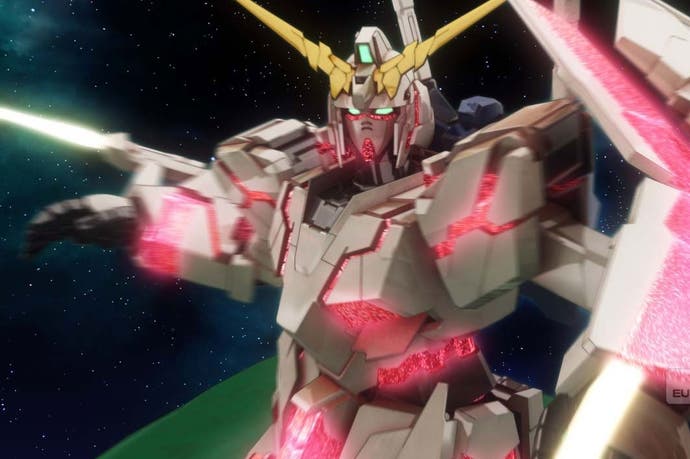Dynasty Warriors Gundam 3 retrospective
Musou soup.
It's often assumed that all of Tecmo Koei's Musou titles are largely the same game. You're some powerful warrior, you run around chopping at large groups of cannon fodder, then beat up some tougher opponents with names over their head. When you've duffed up enough of them, you've won. You do this over and over until the game has nothing left to give, and that's that. This is, perhaps, the most reductively shallow and inaccurate appraisal in video games history. It's akin to saying racing games are just pressing two buttons and moving left and right to be faster than everyone else, or that shoot 'em-ups are nothing but holding down the fire button and avoiding bullets.
Dynasty Warriors Gundam 3 was released in 2010 and found its way to European shores in 2011. At first glance, it's a cel-shaded hybrid of Bandai's legendary mecha universe and Dynasty Warriors' slash-happy crowd clearing. Bearing no relation whatsoever to the combat seen in the various strains of Gundam anime series, it's a curious link-up. After two previous games, it seemed that the third title would be business as usual.
It's not. It's actually the Musou concept abstracted and quantised into a much deeper experience that's closer to Disgaea than Dynasty Warriors tradition. It's a game that places player choice at the heart of matters, setting a target of optimisation and efficiency. It's a title that offers an impressive curve of progress and longevity, where the endgame clears away any restriction on pilot and mecha choice, and where the degree of challenge is entirely the player's to decide. It can be a leisurely romp in big robots or a bastard-hard fight for survival, and Dynasty Warriors Gundam 3 never takes away your option to decide which end of the spectrum you want to play.
The critical differences are twofold. Firstly, the game's stages are mostly dynamically generated for each play-through and can feature a number of zones that have dramatic effects on the overall battle. Capturing enough zones tips the tide and prompts the boss to appear, but secondary objectives offer additional rewards. These objectives are also dynamically selected. Secondly, the Gundam mecha work as vehicles that can be upgraded and then democratised for any pilot character to use. Customisation options allow specialisation in a system that does away with any overt classing, and sacred storyline laws are dissolved in much the same manner as within the Warriors Orochi games.
There are also a lot of Gundam suits to unlock, and most of them become remarkably badass given the necessary investment. Brilliantly, any unlocked skill can be applied to any mecha or pilot, provided they have the slots. Quite why this dizzying freedom and complexity was allowed for the Gundam universe is unclear, but it's a shake-up of convention (and a delightfully playful implementation of IP) that's so rare in gaming that I think it's genuinely unique.
Naturally, each stage's objective is the same - clear enough of the enemy to coax out the stage's boss and then defeat it - but this uniformity is far more a strength than a weakness. These games aren't about rollercoaster excitement or cinematic action. They're about efficiency, or rather the quest for more of it. You have one clear overall objective, so every single run you make is about improving your competence at completing that objective. As you unlock stages that are increasingly dense with enemies, the demand on technique increases. It's not really a case of blindly levelling up the mecha to deal with bigger crowds, but using that increased power to make your run faster and cleaner, or more comprehensive.
You might start off on Easy difficulty and take the quickest route to defeating the boss, but taking the time to clear every zone on the map will give you more cash and mecha plans (the means of creating more powerful base stats for each suit) and aid your overall progress. Playing on Hard will reap huge rewards and far better plans, but it's genuinely hard and unless you're well-versed and well-equipped, you will be utterly destroyed.
The core joy of any Musou title is the fighting. In the grand panoply of Musou titles, Dynasty Warriors Gundam differentiated itself by adding some new combat mechanics from the start. And the action is superb - the Gundam universe has always created devastatingly cool and impressive robot suits, so to command them in action with a lovely cel-shaded effect is a delight. Especially when they're levelled and configured, thanks to a surprisingly meaty and satisfying interpretation of each suit's features into the Musou combat language.
When Dynasty Warriors Gundam 3 hits its peak it generates a transcendent freneticism where instinct takes over. When there's a big crowd to clear and one or more named enemies in the melee, the Musou experience becomes sublime and Dynasty Warriors Gundam 3 does this with aplomb. You know which combos soften the crowd for a quick clear-up, but you know the enemy pilot is nearby and may Musou you in the face at any time, so you have to be ready to switch to a more directed string that focuses your damage.
You're fighting on the fly, assessing the crowd and keeping watch for danger as you go about your work. You're often fighting with a kind of blinkered blindness, feeling your way as you go, but the controls allow you to direct your momentum in the direction it's needed within a few button presses. Camera be damned - you don't need it to be in the right place all the time. Instinctively, you're commanding your mecha like the one-pilot death machine it's meant to be. It's in the thick of this that you reach Musou nirvana; within a minute, the dust settles and you've KOed 60 enemies without taking a hit, leaving a scattering of power-ups for you to soak up before moving to the next zone.
There's pride in doing this quickly and cleanly. There's pride in doing it with technical finesse and without special attacks. f you can dig that urgency and the urgent deployment of power, and want to get more efficient at it, then you're going to have a lot of fun with the Musou games. Where Dynasty Warriors Gundam 3 elevates itself is by segmenting the battlefield so your progress is much more obvious and tangible, where a well-planned route means you're always fighting and never wasting time. Of course, the core fighting action is wrapped in silly storylines and arbitrary side-missions but these are subservient enough to the gameplay they never intrude on that march for efficiency and never hinder it. This is a rare thing in the modern age - a game that's happy being a game first and a multimedia interactive experience second.
The Musou titles are genuine curios - they're weirdly educational in their Dynasty and Samurai Warriors guises, and serve as cultural encyclopedias in the licensed-IP ones. They're fabulous long-players, working brilliantly as games that can be left for months and then picked up again, thanks to their surface simplicity and fine granularity. They offer plenty of rewards for concerted play and find a rhythm that's beguiling and addictive when the heat is on. It's hard to see them as simplistic low-brow button mashers once you've got the efficiency bug and in split-screen co-op, can be a total riot. They let you decide the difficulty you want, and devise your own power-levelling styles as a result.
Dynasty Warriors Gundam 3 celebrates all this while maintaining an individual differentiation from the pack (even though every single Musou title has unique features and amendments to the base concept), and it does it with fabulously designed mecha, in a gorgeous graphical style. If you're a virgin or a hater, Dynasty Warriors Gundam 3 is the one to try, to see where those shallow critiques miss the point entirely and where developer Omega Force's insane pace of iteration has evolved its own, deliciously potent version of gaming MSG. If you like what you find, graduate to Warriors Orochi 3, for I'm sure Dynasty Warriors Gundam 3 is the series' best gateway drug.






















